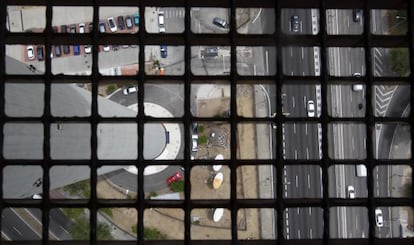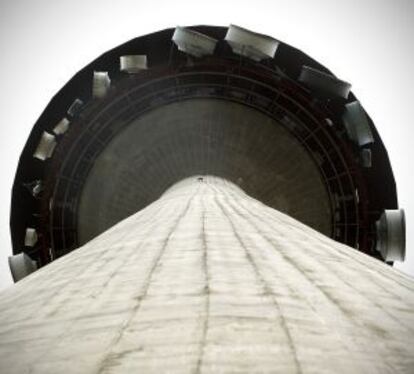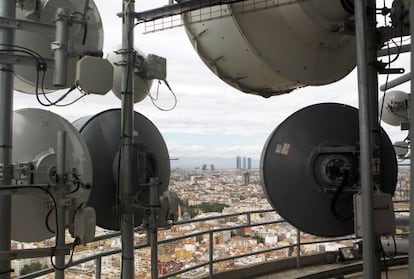Madrid's 30-year-old giant lollipop
Built to coincide with the 1982 World Cup, the Torrespaña communications tower came to symbolize a Spain confident about its future

In the summer of 1982, just seven years after the death of General Francisco Franco, Spain hosted the World Cup, ushering in a new era of confidence and hope in the future as the country left behind four decades of military rule.
In the run-up to the global soccer event, the poor state of the capital's communications, unable even to provide good signals to some parts of the city, became increasingly clear. So, in February 1981, work began on a state-of-the-art communications tower on the eastern edge of Madrid, close to the M30 beltway.
The construction project broke all records. The works started on February 17, 1981 with the excavations and were completed in February 1982 after only 12 months. Between February and May 1982 all the auxiliary fittings, from the control room and the radio links to the satellite dishes, were installed. As the 212-meter tower rose up into the Madrid skyline, it was soon dubbed el Pirulí, after a popular ice pop of the time.
At a cost equivalent to around 22 million euros, Torrespaña came into service as a National Telecoms Hub on the night of May 18, 1982. It was officially inaugurated by the King and Queen of Spain on June 7, 1982, the day before the World Cup got underway.
Three decades later, Torrespaña is the nerve center of the telecommunications and audiovisual Network of Abertis Telecom. It is the main radio and television signal emitter center for the Madrid region, providing over five million people with 43 free-to-air digital television channels, 15 analogue radio stations and 12 digital radio stations.
It also provides services for telecoms operators such as British Telecom, Ono, and Orange. However, the telephone coverage from the Pirulí's 160-meter observation platform is fairly poor.

"It's because the antennae point downward, where most people are," explains Roque Moreno, the tower's director, in rather condescending fashion.
At this height the wind can really be felt, at times producing a slight, albeit disconcerting sway. A few months after its opening, the tower was hit by a powerful storm when it was transmitting a Rolling Stones concert. "We had a pendulum in the control room here to check the oscillation," says Moreno. It measured that the tower had moved almost half a meter from the perpendicular.
Moreno was barely out of university when the Pirulí opened and he had begun working at state broadcaster RTVE. In 1989 he joined Retevisión, RTVE's transmission division, which was subsequently privatized, and then bought out by infrastructure company Abertis, the current owner of the tower.
Moreno has spent his career looking after the tower, a job he shares with a team of 19 people. "We like to keep out of the limelight: that means that everything thing is going well," he says.
But when something does go wrong, most of the city soon learns, as happened in August 2002, when a fire in the tower left the capital without television for more than three hours.
Emilio Fernández Martínez de Velasco, the tower's architect, says the Pirulí's appeal lies in the principle of form following function. "The initial design was more than reasonable - neither the initial proportions nor the structural concept were changed. And the technical competence of the successful bidding companies at every level, from the first to the last; favorable climate conditions; and well-conceived planning made the process a breeze," he says. "For me it was, frankly, enjoyable because of the novelty factor and the fantastic company."
It remains one of his favorite projects, and he visits the tower regularly: "I like going up in the lift: there's more than enough time to lay down the foundations of lasting friendships with chance traveling companions. I also like the way the outside has changed over the years, I like it as it is now, covered with electronic junk."
Andrés Jaque, one of Spain's best-known architects, says that while the Pirulí has won a place in the hearts and imaginations of Madrileños, it is more because of what it represents, or represented. "It was a symbol of processes that were going on under the surface in Spanish society; it was a daily reminder of the growing importance of long-distance communications, of Spain's links to the wider world," he says.

But he bemoans what he sees as the lack of design in the Pirulí, comparing it unflatteringly to Norman Foster's Collserola communications tower in Barcelona. "The antennae and equipment that now adorn the Pirulí are more attractive than the tower itself," he says.
Juan Miguel Hernández León, one of Spain's leading academic experts on architecture agrees on the Pirulí's symbolic status, but says it will never be a global icon. "It's not exactly the Eiffel Tower, is it?" he laughs. "It is an artifact, like so many others, but it never aroused much passion, perhaps because it was located out of the way, at a time when the M30 was the edge of the city."
I like it as it is now, covered with electronic junk," says its architect
It's true that the Pirulí is not located for maximum visual impact. Although at the time of its construction, it was the capital's tallest structure, it never dominated the skyline, probably because it is built in a depression some 60 meters below the city's highest point, further off to the north.
While it may have divided architects, Torrespaña captured the imagination of the public, and a generation of musicians, who also saw the symbolism of the tower in what was still a low-rise country, in all senses.
Víctor Manuel, a singer-songwriter who made his name in the optimistic 1980s alongside his actor-singer partner Ana Belén, wrote Desde el Pirulí se ve un país a few months after Torrespaña was completed - "Desde el pirulí se ve un país, confundido y feliz de perfil, que anda descubriendo como es, aunque sepa muy bien lo que no quiere ser. [From the Pirulí a country can be seen, confused and happy in profile, that is still discovering itself, although it knows very well what it doesn't want to be.]"
"The first time I saw it, I thought it was a flying saucer, nobody had any idea what was inside it," Manuel remembers. "It immediately became a symbol of Spain's hopes for the future, and it was the first step in creating a new urban landscape, imposing."
Within two years of the tower's appearance, Joaquín Sabina, sometimes dubbed Spain's Bob Dylan, referred to it as Telespañolito in a song that attacked the country's mediocre television output, cleverly calling for Spaniards' imagination to rise to the heights of the Pirulí.
In 1988, journalist Fernando García Tola broadcast his interview and music program Querido Pirulí (or, Dear Pirulí) live from Torrespaña. The same year, Oscar-winning film director Pedro Almodóvar featured it in his film Women on the Edge of a Nervous Breakdown, joining a long list of moviemakers fascinated by the impact of the new addition to the Madrid skyline.
A year later, when one-hit wonders Los Refrescos went to the top of the charts with their summer-in-the-city anthem Aquí no hay playa, the Pirulí was already sufficiently part of the urban landscape to be listed alongside the Cibeles fountain among the capital's attractions.
If Spain was confused and happy in 1982, three decades later, it is still arguably confused, but a lot less happy. As Víctor Manuel notes: "Perhaps we now know better who we are, but I don't think we like what we see in the mirror."
Tu suscripción se está usando en otro dispositivo
¿Quieres añadir otro usuario a tu suscripción?
Si continúas leyendo en este dispositivo, no se podrá leer en el otro.
FlechaTu suscripción se está usando en otro dispositivo y solo puedes acceder a EL PAÍS desde un dispositivo a la vez.
Si quieres compartir tu cuenta, cambia tu suscripción a la modalidad Premium, así podrás añadir otro usuario. Cada uno accederá con su propia cuenta de email, lo que os permitirá personalizar vuestra experiencia en EL PAÍS.
¿Tienes una suscripción de empresa? Accede aquí para contratar más cuentas.
En el caso de no saber quién está usando tu cuenta, te recomendamos cambiar tu contraseña aquí.
Si decides continuar compartiendo tu cuenta, este mensaje se mostrará en tu dispositivo y en el de la otra persona que está usando tu cuenta de forma indefinida, afectando a tu experiencia de lectura. Puedes consultar aquí los términos y condiciones de la suscripción digital.
Últimas noticias
Chris Martin, Taylor Swift, Elijah Wood and other famous wedding ‘crashers’
‘How does it feel to be a failure?’: Elizabeth Berkley’s journey from ‘Showgirls’ ridicule to vindication
The story of the Málaga virus: The code that haunted Google’s cybersecurity center director for 30 years
The impact of Ecuador’s mega-prison: A polluted river, cleared forests and military checkpoints
Most viewed
- Christian Louboutin: ‘Young people don’t want to be like their parents. And if their parents wear sneakers, they’re going to look for something else’
- The low-cost creative revolution: How technology is making art accessible to everyone
- All the effects of gentrification in one corner of Mexico’s Colonia Roma
- Liset Menéndez de la Prida, neuroscientist: ‘It’s not normal to constantly seek pleasure; it’s important to be bored, to be calm’
- December Social Security and SSI payments: Dates, double checks and the 2026 COLA increase








































